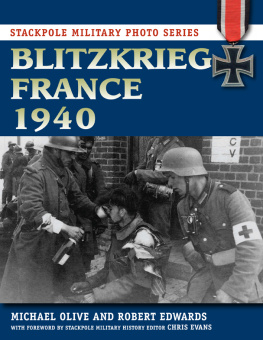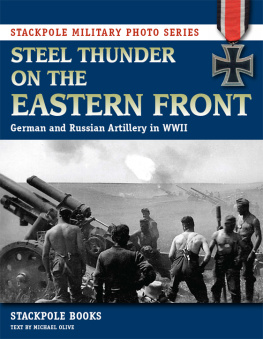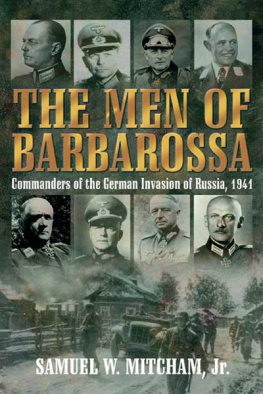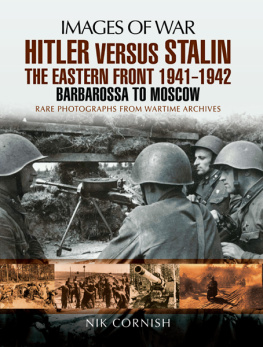
Copyright 2012 by Stackpole Books
Published by
STACKPOLE BOOKS
5067 Ritter Road
Mechanicsburg, PA 17055
www.stackpolebooks.com
All rights reserved, including the right to reproduce this book or portions thereof in any form or by any means, electronic or mechanical, including photocopying, recording, or by any information storage and retrieval system, without permission in writing from the publisher. All inquiries should be addressed to Stackpole Books.
Cover design by Caroline M. Stover
Printed in the United States of America
10 9 8 7 6 5 4 3 2 1
Library of Congress Cataloging-in-Publication Data
Olive, Michael.
Operation Barbarossa, 1941 / Michael Olive and Robert J. Edwards ; with a foreword by Chris Evans.
p. cm. (Stackpole military photo series)
Includes .
ISBN 978-0-8117-1078-7
1. World War, 19391945CampaignsSoviet Union. 2. World War, 19391945CampaignsSoviet UnionPictorial works. 3. Soviet UnionHistoryGerman occupation, 19411944. 4. Soviet UnionHistoryGerman occupation, 19411944Pictorial works. I. Edwards, Robert J. II. Title.
D764.O45 2012
940.54'217dc23
2012000336
eBook ISBN: 9780811745802
Contents
FOREWORD
I n 2003, Stackpole Books launched the Stackpole Military History Series with just two titles. Nine years on, the series continues to grow, with over 140 titles now available. Whether its a first-person account by an American paratrooper humping through dense, light-blocking triple-canopy jungle in Vietnam, noted historians bringing new perspectives on the desperate combat between Arabs and Israelis in the Middle East, or a Swedish volunteer fighting with the Waffen SS on the Eastern Front in the Second World War, youre liable to find it in the series.
Having created a large library of the most riveting and detailed military history titles around, we started thinking about what we could do next to further explore the complex and varied history of military conflict around the globe. We strive to include strong photographs in each book, but theres only so much space for photos in a narrative history. To add to the challenge, authors dont always have a wealth of photos at their disposal. What if, I pitched to the publisher, we launched a new series that was all about the photos? What if we scoured the archives, attics, museums, and as many small and not so small privately held collections all over the world in order to bring together hundreds of photographs in each bookmany never before publishedto create detailed, informative, and affordable books? Well, youre holding the answer in your hands.
Each title in the Stackpole Military Photo Series is designed as a stand-alone photographic narrative of some of the most pivotal military events in modern history. When we began to search for the perfect topic to launch the series, the mammoth and world-altering Operation Barbarossa, the German invasion of Soviet Russia on June 22, 1941, became the obvious choice. From the opening salvo, the war between Adolf Hitlers Third Reich and Joseph Stalins Communist Russia devolved into one marked by ever-increasing acts of barbarity, fanaticism, genocide, and the wide-scale destruction of property, the environment, animals, and, above all, people.
While it might be true that a photograph is worth a thousand words, German World War II military history experts Michael Olive and Robert Edwards provide added depth and detail by illuminating every photo with engaging captions, many of them quoted directly from the soldiers themselves. Using many previously untapped sources, youll race through humble villages and across vast steppes with the vaunted panzers, the armored fist of Germanys blitzkrieg. Youll see the wear and tear on men and machines as the Wehrmacht drives ever deeper into a Soviet Union that they fervently believe, as Hitler promised, would come crashing down. And as winter looms, photos of German landsers marching across mile after mile of seemingly endless Russian steppes convey the dawning realization of these warriors that the quest for lebensraumliving spacewould not be so easily acquired.
From scenes of heavy artillery lobbing shells into straw-thatched villages to pioneers braving enemy fire to construct temporary bridges over the next river in order to keep the schwerpunktspearheadmoving forward, Operation Barbarossa 1941 puts you in the thick of battle. Youll witness the heroism, the fear, the fire, and the blood, all through the stark, unflinching camera lens of photographersoften soldiers themselvesstanding or crouching just yards away.
As the editor for military history books at Stackpole, I am proud to welcome you to our new series. Whether youre looking for a photographic companion to a combat narrative or clear, high-resolution shots for reference for super-detailing your next model, or wanting to immerse yourself in a visual journey of ferocious combat, youll find it here.
Chris Evans
Editor
Stackpole Books
INTRODUCTION
I t had always been Hitlers intention to invade Russia, for both ideological and economic reasons. The campaign in the West, although brilliantly successful, was effectively a sideshow. Russia remained the main enemy.
Accordingly, on December 18, 1941, Hitler issued Directive No. 21Case Barbarossa. This directive stated:
The German Armed Forces must be prepared, even before the conclusion of the war against England, to crush Soviet Russia in a rapid campaign (Case Barbarossa).
The Army will have to employ all available formations to this end, with the reservation that occupied territories must be insured against surprise attacks.
The Air Force will have to make available for this Eastern campaign supporting forces of such strength that the Army will be able to bring land operations to a speedy conclusion
The directive goes on to state that orders for the deployment would be issued eight weeks before the operation was to begin. Preparations for the invasion were to be concluded by May 15, 1941.
The intent of the operation was that the Russian Army stationed in Western Russia be destroyed by armored units penetrating deep into Russia, thereby preventing any forces from withdrawing.
It was in the Battle of the Frontiers where the bulk of the Russian Forces were expected to be destroyed. This was the decisive prerequisite for success: the Red Army had to be annihilated west of the line Divina-Dnieper.
The final objective of the campaign was to form a barrier from the Volga to Archangel. From this location, any surviving Russian industry located in the Urals could be eliminated by the Luftwaffe.
The plan of the campaign was to concentrate two powerful army groups north of the Pripet Marshes. One army group was to operate in the south with the objective of the Donets Basin and its vital industries. Moscow was to be attacked only after Army Group Center had linked up with Army Group North, advancing from East Prussia and capturing Leningrad.
At 0315 hours on Sunday, June 22, 1941, 3.6 million German and allied soldiers with 600,000 vehicles, 3,600 tanks, 7,100 artillery pieces, and 2,700 aircraft crossed the frontier. Opposing these forces were 2.9 million Soviet soldiers of the Western Military District with 15,000 tanks, 35,000 artillery pieces, and approximately 8,500 aircraft.
The front was torn apart by a massive artillery barrage followed by rapid advances of the armored and mechanized units. The Soviets were caught completely by surprise. The Luftwaffe soon established almost complete aerial superiority, destroying hundreds of Russian aircraft on the ground in the first few hours of the attack. The Russian air force lost over 1,200 aircraft in the first eight hours of the attack.
Next page










